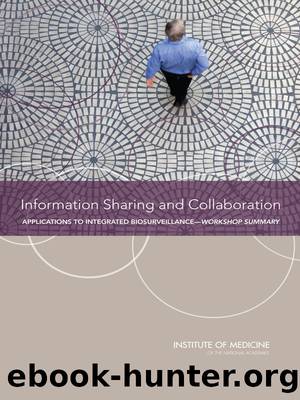Information Sharing and Collaboration: Applications to Integrated Biosurveillance: Workshop Summary by Deepali M. Patel

Author:Deepali M. Patel
Language: eng
Format: epub
Tags: ebook, book
Publisher: THE NATIONAL ACADEMIES PRESS
Published: 2012-12-24T00:00:00+00:00
THIRD MOVE
In the third move, the source of the exposures turns out to be bean sprouts contaminated with E. coli. There is no credible evidence of terrorism, but the investigation continues.
Braden emphasized the difficulty of identifying such a source. Implicating bean sprouts could mean finding a person who ate bean sprouts, knows where the bean sprouts were bought, and had a shopping card linked to a shopping card database to show when the bean sprouts were bought. âGetting that kind of information is quite hard. People donât remember that they ate bean sproutsâitâs often kind of a stealth vehicle.â Yet an accurate trace back is essential to keep partner agencies from being led astray.
Braden also observed that identifying a specific pathogen increases the ability to predict what is going to happen. For example, E. coli can produce different types of Shiga toxins, which will influence the characteristics of the outbreak. This information in turn would need to be conveyed to public health authorities at all levels. He also pointed out that this system is currently threatened, because more and more clinical laboratories are adopting non-culture-based diagnostics, which means that cultures are not available to characterize infectious organisms. âWeâre not going to have that isolate and be able to characterize it to be able to know what to do.â
Braden also described the difficulty of acting as a communicator at CDC while participating in an investigation. âSometimes the incident commander is spending half the time in the studios in front of the cameras.â Joint press conferences with all of the involved agencies on the phone, along with as many as 150 reporters, also take up time.
Tan reiterated that the epidemiological information starts with state and local health departments. USDA can rely on internal databases to investigate hypotheses, but without enough information the investigation cannot proceed. âThe boots-on-the-ground element cannot be underestimated, because thereâs often not enough information for us really to understand exactly what establishment [was involved], what were the production dates, what are the lot codes. Often, people unwrap their food and then they toss the package, and all of our information goes into the garbage. And our folks on the ground are not adverse to going into the garbage and getting the information for us. They can, they have, they remind me often.â
Kautter observed that implicating bean sprouts is a significant advance because it provides a path to pursue. Bean sprouts are not particularly seasonal, but if the contaminated food were seasonal, the first question to ask would be where the food is grown that time of year. If the food was imported, were import samples taken, or are there domestic samples that can be tested? Can the genetic fingerprint of an infectious organism from the food be linked to a clinical sample? Also, once a source is known, industry calls become much more numerous, because industry or trade associations could have information about the origins and treatment of the food.
On this point, Quitugua said that NBIC would not necessarily have all of the information that other agencies have.
Download
This site does not store any files on its server. We only index and link to content provided by other sites. Please contact the content providers to delete copyright contents if any and email us, we'll remove relevant links or contents immediately.
Parents as Care Managers by Gillian Bridge(697)
The Tapestry of Memory: Unraveling the Threads of the Mind by Bittner Karis & Chianese Gabriella & Priede PhD David L(540)
So Young, So Sad, So Listen: A Parents' Guide to Depression in Children and Young People by Philip Graham Nick Midgley(531)
Lucid Dying by Sam Parnia(472)
Vital Signs by Izzy Lomax-Sawyers(443)
Prepare the TCM License exam in a month Vol. 3: Acupuncture theory - channels, points, techniques and treatments(California, NCCAOM, Canadian exam) by Woosen Ur(391)
Oxford Textbook of Global Public Health by Roger Detels;Quarraisha Abdool Karim;Fran Baum;Liming Li;Alastair H Leyland;(358)
The Censorship of Second Opinions: How the politics of "misinformation" captured healthcare during the Covid-19 pandemic by Ariel Herron(342)
IVF Got This by Colette Centeno Fox(342)
Wilderness and Survival Medicine by Ellis Chris Breen & Dr Craig(280)
Introduction to Social Work Practice : A Practical Workbook by Herschel Knapp(279)
Eating and Growth Disorders in Infants and Children by Joseph L. Woolston(274)
How Data Happened by Unknown(258)
Boxed Set 1 Dermatology by Dr Miriam Kinai(256)
Selective Oxidation Catalysts Obtained by the Immobilization of Iron (III) Porphyrins on Layered Hydroxide Salts by Fernando Wypych Shirley Nakagaki & Guilherme Sippel Machado(246)
Zika Virus Biology, Transmission, and Pathways by Colin R. Martin(243)
Snake Oil: How Xi Jinping Shut Down the World by Michael P. Senger(237)
Positive health: 100+ research-based positive psychology and lifestyle medicine tools to enhance your wellbeing by Jolanta Burke Pádraic J. Dunne Trudy Meehan Ciaran A. O'Boyle Christian van Nieuwerburgh(233)
Global Health Governance and Commercialisation of Public Health in India by Anuj Kapilashrami Rama V. Baru(216)
